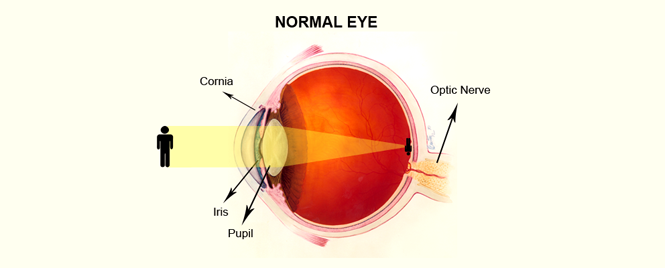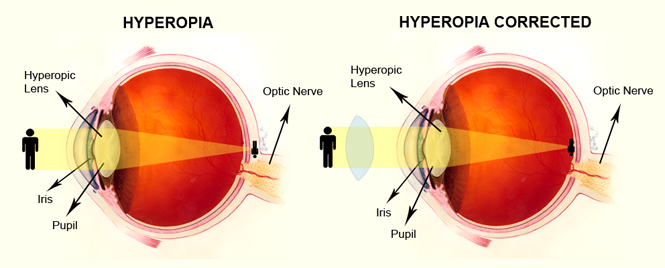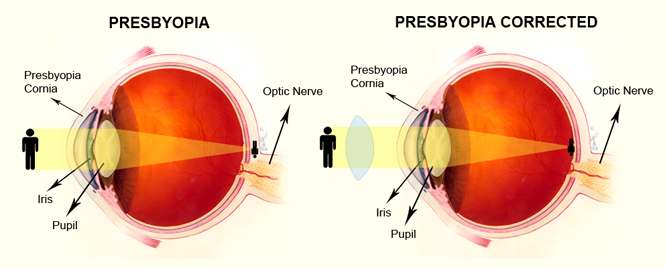When you look at a distant object, light rays from the object pass through your eye and hit the retina. This causes nerve messages to be sent from the cells of the retina down the optic nerve to the vision centre in the brain, where the image is processed as an object that you recognise.
The light rays should focus on a small area of the retina, otherwise that object will appear blurry. The cornea and lens at the front of your eye help to focus the object by bending the rays of light in a process known as refraction.
For close objects, the lens must increase its power and become more rounded (known as accommodation). For objects further away the lens remains flatter.

MYOPIA
If you can’t see distant objects clearly, you are said to be short sighted or Myopic. Myopia occurs when your eye is unable to focus the incoming rays of light on the retina despite the lens being as flat as possible.
Most myopes can see close objects clearly and that’s why they may remove their spectacles to read. Myopia can be caused by an eyeball that is too long or a lens with a very high power and often has a genetic link.
The onset of myopia usually occurs in the early years. It tends to stabilise towards 30 – 40 years, after which it commonly reduces so that you become less myopic.
Myopia can be corrected by using concave (minus powered) lenses in front of the eye. These have the ability of bending the light forward until it focuses on the retina.
A concave lens is thicker on the edge compared with its centre. High index (thinner lenses) are therefore recommended for high myopic prescriptions to reduce thickness and weight and to improve appearance.

HYPEROPIA
Hyperopia is caused by an eyeball which is too short or a lens that is weaker than necessary. As a result, the rays of light entering the eye does not focus on the retina but behind it. As your eye has some degree of control (accommodation) it is usually able to focus objects far away, hence you can see clearly in the distance. Closer objects require a lot more effort and if this is not possible, appear blurry.
Hyperopes need a convex or positive powered lens to bring the focal point of the rays of light forward and onto the retina. Positive lenses can be used to correct both hyperopia and presbyopia.
A convex lens is thicker in the middle compared to its edge. For high prescriptions, a flatter, aspheric lens is recommended in order to avoid the lens appearing too bulbous.

PRESBYOPIA
You may have noticed children holding books very close to their eyes and still being able to read the words without any problem. Throughout life, we tend to hold objects further away from our eyes as this feels more comfortable.
Presbyopia tends to occur in the mid to late forties. The reason for this is that over time the lens becomes harder and therefore less elastic. As a result, its ability to focus close objects reduces (loss of accommodation). A prescription for close work (eg reading, computer etc) is given in order to help relax the eyes and improve close vision.

ASTIGMATISM
If the shape of the cornea or lens is oval like a rugby ball, it has two different curves, rays of light entering at different angles will therefore be brought to focus in two different positions, producing a distorted image. This condition is known as astigmatism.
However, if the shape of the cornea or crystalline lens is round like a football, it has the same shaped curve all the way round. Rays of light entering the eye from any angle will be brought to a focus at the same point.
Astigmatism is very common and is present in most people. It is corrected with a lens that has 2 different powers running 90% to each other. This is known as a toroidal or toric lens.



